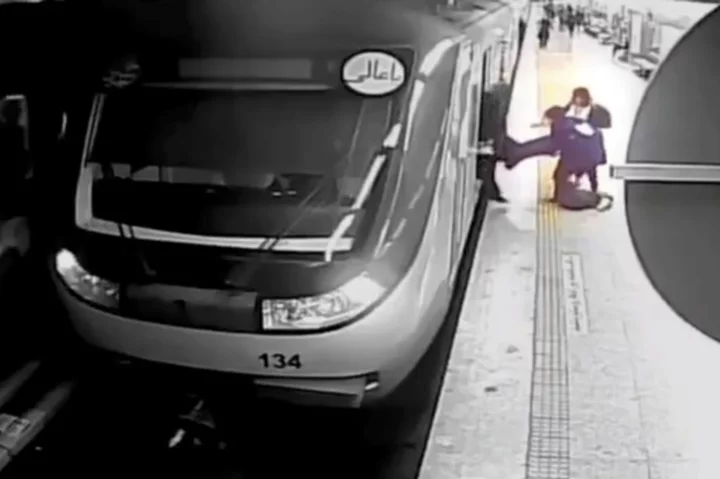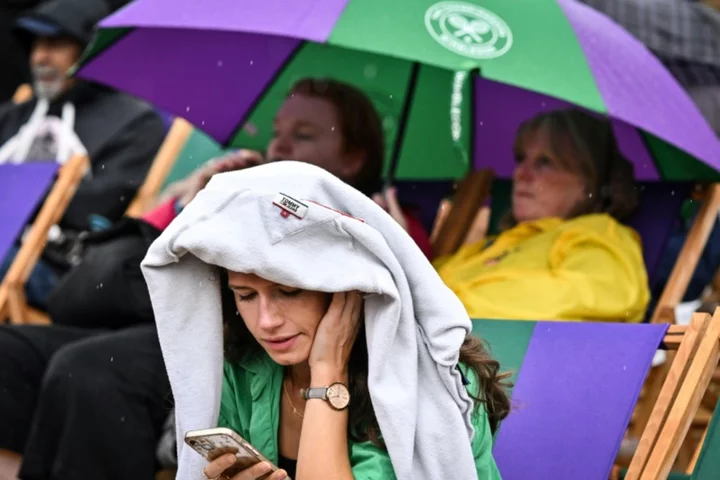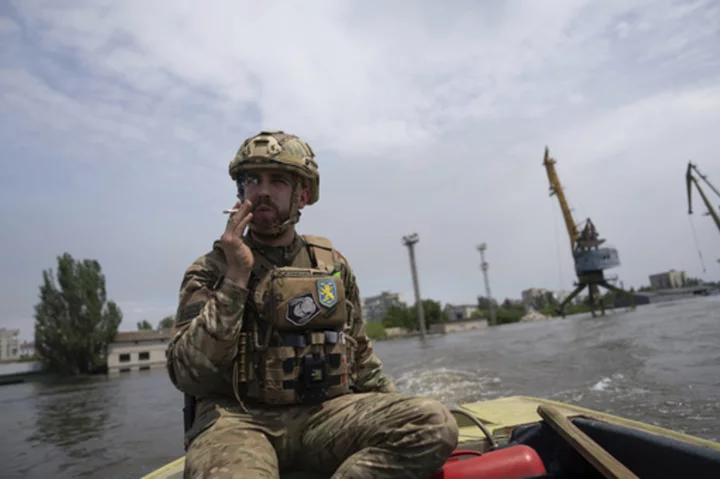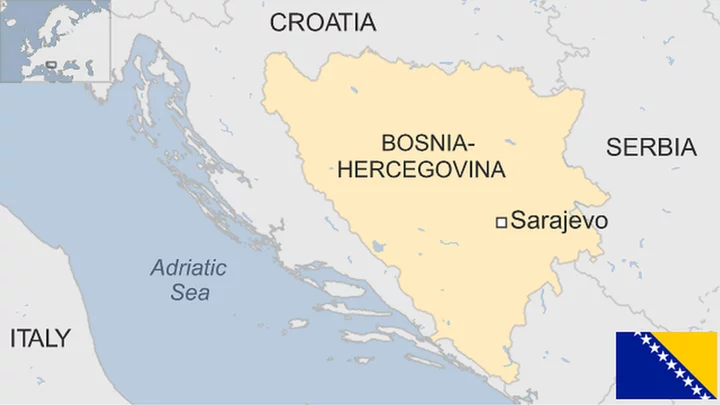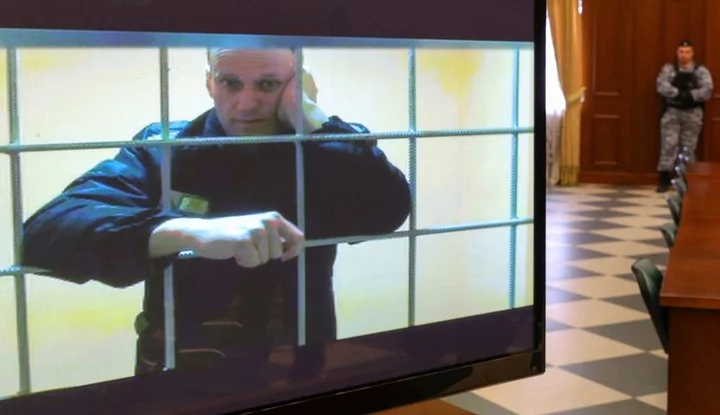DUBAI, United Arab Emirates (AP) — A mysterious injury suffered by a 16-year-old girl who boarded a Metro train in Iran’s capital without a headscarf has reignited anger just after the one-year anniversary of the death of Mahsa Amini and the nationwide protests it sparked.
What happened in the few seconds after Armita Geravand entered the train on Sunday remain in question. While a friend told Iranian state television that she hit her head on the station's platform, the soundless footage aired by the broadcaster from outside of the car is blocked by a bystander. Just seconds later, her limp body is carried off.
Geravand’s mother and father appeared in state media footage saying a blood pressure issue, a fall or perhaps both contributed to their daughter’s injury.
Activists abroad have alleged Geravand may have been pushed or attacked because she was not wearing the hijab. They demand an independent investigation by the United Nations' fact-finding mission on Iran, citing the theocracy's use of pressure on victims' families and state TV's history of airing hundreds of coerced confessions.
Geravand's injury also comes as Iran has put its morality police — whom activists implicate in Amini's death over her alleged loose hijab — back on the street, and as lawmakers push to enforce even stricter penalties for those flouting the required head covering.
“Girls are subjected to violence on the streets, and then their families are compelled to protect the government responsible for that violence,” said Hadi Ghaemi, the executive director of the New York-based Center for Human Rights in Iran.
For observant Muslim women, the head covering is a sign of piety before God and modesty in front of men outside their families. In Iran, the hijab — and the all-encompassing black chador worn by some — has long been a political symbol as well, particularly after becoming mandatory in the years following the 1979 Islamic Revolution. Iran and neighboring Taliban-ruled Afghanistan are the only countries where the hijab remains mandatory for women.
Since Amini's death and the large-scale protests subsided, many women in Tehran can be seen without the hijab in defiance of the law.
Geravand suffered her injury Sunday morning at the Meydan-E Shohada, or Martyrs' Square, Metro station in southern Tehran. Rumors about how she suffered the injury quickly circulated.
By Tuesday, the Hengaw Organization for Human Rights, which reports on abuses in Iran's western Kurdish region, published a photograph it said showed Geravand at the hospital, her head wrapped in bandages as she remains in a coma.
Geravand “was physically attacked by authorities in the Shohada station at Tehran Metro for what they perceived as noncompliance with the compulsory hijab,” Hengaw alleged, citing reports it said it received. “As a result, she sustained severe injuries and was transported to the hospital.”
The Associated Press has not been able to confirm the exact circumstances of what caused Geravand's injuries.
Late Wednesday, Iranian state television aired what appeared to be nearly all the surveillance camera footage covering the 16 minutes Geravand spent inside of the Metro station before her injury. She entered at 6:52 a.m., then went down an escalator. The sole gap, about a minute and a half, occurs before she reaches the turnstile gate where she uses her Metro card. The footage includes her shopping for a snack, then walking to and waiting on the platform for the train.
In the mute footage, Geravand, whom activists describe as a taekwondo athlete, appears calm and healthy. An AP frame-by-frame analysis of the footage showed no signs of the aired video being manipulated.
At 7:08 a.m., Geravand enters the No. 134 train car — the last on the train and likely a women-only compartment. A new conductor for the train walks up as she enters, his body blocking the view of door she walks through. Within four seconds, a woman steps backwards out of the train and just a sliver of Geravand’s head can be seen as she lies on the floor of the train. Women then pull Geravand’s limp body out and run for help as the train moves off.
Iranian state TV's report, however, did not include any footage from inside the train itself and offered no explanation on why it hadn't been released. Most train cars on the Tehran Metro have multiple CCTV cameras, which are viewable by security personnel.
"Refusing to publish the footage only increases doubts about the official narrative," the Oslo-based group Iran Human Rights said.
Emergency medical technicians took Geravand to Fajr Hospital, which is at a Iranian air force base and one of the the closest medical facilities to the station. In the time since her injury, security forces have arrested a journalist for Shargh newspaper who went to the hospital, according to the New York-based Committee to Protect Journalists. Shargh, a reformist newspaper, helped lead reporting surrounding Amini's death as well.
Already, Geravand's injury has drawn international attention, something Iran's government has sought to dismiss. German Foreign Minister Annalena Baerbock wrote online: “Once again a young woman in #Iran is fighting for her life. Just because she showed her hair on the subway. It’s unbearable.”
U.S. Deputy Special Envoy for Iran Abram Paley also wrote that he was “shocked and concerned about reports that Iran’s so-called morality police have assaulted 16-year-old Armita Geravand.”
Iranian authorities likely worry about this incident escalating into popular anger like in Amini's case. Women continue to ignore the hijab law despite the growing crackdown. That includes what Shargh described as Tehran's city government hiring of some 400 people as “hijab guards” to give verbal warnings, prevent uncovered women from entering subway cars and hand them over to police.

